T
his road is as close as you can get to Iceland’s interior and F-roads, if you’re not driving a 4×4 vehicle. It’s great and definitely worth the drive. Just make sure with your rental company that you are allowed to drive here.
Some of Iceland’s roads are so specific that they are understandably of greater interest to travelers. Below we have selected the most important ones – both in the ‘asphalt’ and mountain category. See what characterizes them, what interesting things you’ll find on them, and whether it’s worth paying special attention to something when driving on them.
Also read the other guides on driving in Iceland linked at the end of the article.
Iceland’s roads are mostly asphalt, smooth, straight and differ mainly in the quality of the views that can be enjoyed from them.
Exceptions to this would be, for example, the shortcut to Egilsstadir – road 939 in the southeast – steep (according to the sign, as much as 17%!), winding, narrow and gravel. The end of the access road 218 to Dyrholey near Vik is similar (here there is even a ban on non-4X4 driving). And then there’s road 332 leading to the parking lot and viewpoint of the Haifoss waterfall – this is also a fairly steep (well, but not 17%) and narrow gravel road. Wide exceptions will also be the roads on the Cape West Fjords – often both gravel and quite steep.
However, the primary road network in Iceland is well-maintained, though rather narrow, paved roads. Except in winter and periods of exceptionally inclement weather, they allow for comfortable travel. Gas stations, small restaurants, parking lots, campgrounds, stores and hotels – all this infrastructure stands at a fairly high level and is relatively easy to access.
Roads in Iceland are marked with numbers. The more digits, the smaller and less important the road. The most important road in the country – the island’s ring road – is numbered 1, and it is the only road with a single-digit number. The smallest roads have four-digit numbers.
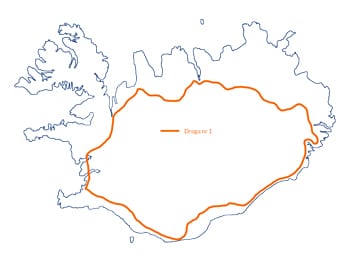 Road No. 1 is about 1,350 km long and circles the entire island, passing through its most important cities. The 1 connects, among others, Reykjavik in the west, Vik in the south, Egilsstadir in the east and Akureyri in the north. It also passes near a huge number of Iceland’s most important attractions – we described them in the article Road 1’s biggest attractions (+ 10 extras).
Road No. 1 is about 1,350 km long and circles the entire island, passing through its most important cities. The 1 connects, among others, Reykjavik in the west, Vik in the south, Egilsstadir in the east and Akureyri in the north. It also passes near a huge number of Iceland’s most important attractions – we described them in the article Road 1’s biggest attractions (+ 10 extras).
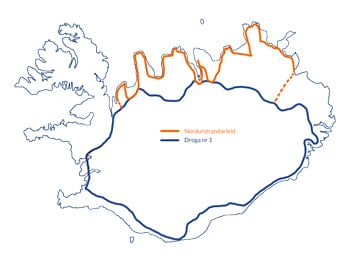 Norðurstrandarleið (Arctic Coast Way) is the name of a group of roads that run along the northern coast of Iceland. The roads have existed for a long time, but as one common road route Nordurstrandarleid was opened on June 8, 2019. The route has a total length of just over 800 km and is marked with special signs.
Norðurstrandarleið (Arctic Coast Way) is the name of a group of roads that run along the northern coast of Iceland. The roads have existed for a long time, but as one common road route Nordurstrandarleid was opened on June 8, 2019. The route has a total length of just over 800 km and is marked with special signs.
Moving along these routes, we can admire the beautiful rugged nature of Iceland, especially the abundance of amazing cliffs. If you’re lucky, you can even spot whales swimming in the ocean!
If you plan to spend a lot of time in Iceland, be sure to consider a trip there. The north coast is not dotted with highlights, but it certainly offers peace, tranquility and direct contact with beautiful and often majestic nature.On the official website of the trail: Arctic Coast Way you will find extensive and up-to-date information about interesting places to visit there.
If you’re looking for scenery with sweeping cliffs and wilderness, be sure to extend your route with a visit to the West Fjords.
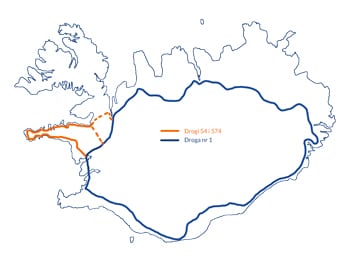 Snaefellsnes is a Cape often referred to as Iceland in miniature. Indeed, in a relatively small area you’ll find (almost) all types of Iceland’s biggest attractions here. Lava fields, beautiful cliffs, waterfalls, a glacier.
Snaefellsnes is a Cape often referred to as Iceland in miniature. Indeed, in a relatively small area you’ll find (almost) all types of Iceland’s biggest attractions here. Lava fields, beautiful cliffs, waterfalls, a glacier.
Several of the attractions here are absolute top spots that should be seen by anyone who wants to explore Iceland. These certainly include:
Snaefellsnes is a small cape, and almost all of its attractions are really interesting. Wanting to collect them into a Top10 list, one would have to list almost all of them 😉 That’s why we don’t have such a list, and if you’re going there, just have a look at all the articles about the Cape’s attractions: attractions of Snaefellsnes.
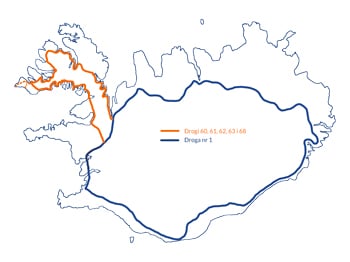 A separate, somewhat specific category is the roads of the Cape West Fjords.
A separate, somewhat specific category is the roads of the Cape West Fjords.
Until recently, these roads were 100% gravel, but today they are mostly covered with asphalt, although for the sake of balance, the asphalt is often in fairly poor condition. Still, in many places they are very narrow and winding roads. At the same time, they are also extremely photogenic – driving along the edge of the fjord at the foot of hills and cliffs can be truly remarkable.
A special feature of these roads is their accessibility in winter. Or rather – the frequent lack of this accessibility. Although the road services do what they can, very heavy snowfall can turn these roads into snow tunnels, and driving them (in winter) absolutely requires four-wheel drive and often snow chains. However, if you are so equipped, a ride through such a snow gutter or tunnel is an additional unusual attraction in itself….Roads 60 and 61 meet in close proximity to the capital of the West Fjords – Isafjordur. Most of the peninsula’s most popular attractions lie along one of these roads. Only to the cliffs of Latrabjarg – considered the best place for observing masconurs – you have to take the side road 612. Meanwhile, the beach of Raudasandur, located near Latrabjarg, is reached by road 614. They are marked on the map with a dashed line in the far west of the peninsula.
You can read about the specifics of driving on them, including in particular the basic rules for crossing fords, in this article Road conditions, regulations and fines in Iceland. In short: always stay alert, check the weather for the next day and stay safe.
Here we will just focus on a fairly concise description of the most important ones.
 The Kjalvegur road is one of the two most important roads connecting the north and south of Iceland. It is the safest of all Icelandic mountain roads.
The Kjalvegur road is one of the two most important roads connecting the north and south of Iceland. It is the safest of all Icelandic mountain roads.
It is so safe that it has now officially lost its F designation and assignment to mountain roads. Officially, it is simply road 35. To put it another way: practically any ordinary car can handle it, even if it does not have a two-axle drive.
There are no water crossings or particularly steep climbs along Route 35. Unless there happen to be some exceptionally adverse weather conditions, you can also manage on it without a 4×4 drive. Road 35 is a safe, well-paved, gravel route. Its northern and southern ends are even covered with an asphalt surface. If you don’t plan to drive off it onto the F347 route leading to Kerlingarfjöll, you’ll drive it with a regular car.
On the other hand, an unpleasant surprise you may encounter on this road is an empty tank, so absolutely remember to refuel your car. From the N1 gas station at Geysir all the way to the N1 or OB station in the north at Blönduós, Vidigerdi or Varmahlíð, there is as much as 200 km of road without refueling. 200 km isn’t very much, of course, but consider the higher fuel consumption on a gravel road than on an asphalt one. It is best to drive here simply with a full tank.
If you’re driving a large motorhome camper, you’re likely subject to a general ban on non-asphalt roads, so the F35 will also remain off-limits to you.
 The F26 (isl. Sprengisandsleið) road is, next to the F35, the second most important road through the interior that connects the south to the north of the island. It is much more interesting in terms of scenery than its western sister. However, it is already a truly off-road road, and only drivers of 4-wheel drive vehicles are allowed on the F26.
The F26 (isl. Sprengisandsleið) road is, next to the F35, the second most important road through the interior that connects the south to the north of the island. It is much more interesting in terms of scenery than its western sister. However, it is already a truly off-road road, and only drivers of 4-wheel drive vehicles are allowed on the F26.
Along the route of the F26 road, one has to cross (shallow) river fords or streams several times, as well as negotiate rather steeply sloping sections. For a 4×4 car, however, these are not problematic obstacles, even if the driver has little off-road experience. All you need to do is to be careful and familiar with the operation of your car. You need to know how to engage the two-axle drive, reducer and differential lock in it.
The strictly off-road route, where you won’t experience the possibility of refueling, is about 240 km in total. However, this is a trip you should definitely take if you want to experience the scenery offered by the Icelandic interior.
To the south – near Hrauneyjar – the F26 road connects to the F208 (description below), which in turn can be used to reach Landmannalaugar and further south around Kirkjubaejarklaustur.
In addition to the attractions at both ends of the road, there are sights to see along the way:
From the F26 you can also descend to the western – the most difficult! – part of the F910 road to Askja.
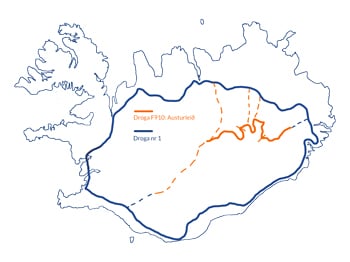 F910 is one of Iceland’s most interesting mountain roads. Its route runs along the northern edge of the Vatnajökull glacier. The F910 stretches between road 933 in the east, near Egilsstaðir and road F26 in the west, north of Nyidalur.
F910 is one of Iceland’s most interesting mountain roads. Its route runs along the northern edge of the Vatnajökull glacier. The F910 stretches between road 933 in the east, near Egilsstaðir and road F26 in the west, north of Nyidalur.
The F910 road can be divided into 3 parts that are very different from each other:
This section of the F910 is only 120 kilometers long, but you’ll need up to eight hours to drive it. When driving through this difficult terrain, you usually won’t even be able to drop into second gear. Add to that the safe time for possible breakdowns such as a punctured tire or a lost route. Almost all of the island’s mountain roads are well marked, but this part of the F910, due to its nature, is an exception. The road is often simply not visible and you must rely on compass navigation. In particular, Google Maps navigation won’t help you here, because as this part of the road doesn’t exist on these maps at all.
The western part of the F910 road requires preparation and caution also because even if your Assistance covers it (which is doubtful), there is no GSM coverage on the road, so it is very difficult to call for help. If you have no off-road experience and are only driving one car, it’s best to just take a different route.
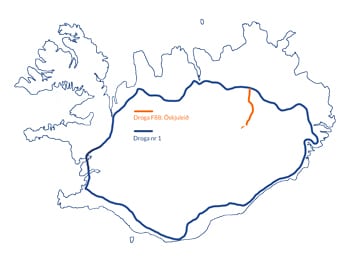 The road designated as F88 is only approx. 80 km long and leads from Road 1 about 30 km east of Myvatn, south to Dreka and the area around the volcano Askja This is one of two roads leading to Askja – the one that is definitely more difficult (the other is the F905 further east – longer, but faster and without danger).
The road designated as F88 is only approx. 80 km long and leads from Road 1 about 30 km east of Myvatn, south to Dreka and the area around the volcano Askja This is one of two roads leading to Askja – the one that is definitely more difficult (the other is the F905 further east – longer, but faster and without danger).
Although in theory F88 is the shortest connection between Myvatn and Askja, this route is by no means easy or fast. In addition to the standard difficulties typical of mountain roads, on the F88 you have to cross two deep fords. They are specially prepared for drivers – the best way to overcome them is clearly marked and described. Nevertheless, you will not avoid driving into the water to the depth of the entire wheels, and often (depending on the model of the car and the state of the water) also the hood of the car. Before entering the water, traffic jams often form, and if a car gets stuck in the water there is no way around it – you have to turn around and drive around.
Before starting the route, ask for information about the water level from the park rangers in Dreki, although you will only know the actual situation on the spot anyway. Keep in mind that in most rental companies this route is not covered by OC or Assistance, and flooding of the car is not covered at all. It is therefore a drive and crossing at your own risk. Especially in case of adverse weather conditions: don’t take any chances. Turning around and going around is always faster than getting stuck in the water and waiting for help.
Alternatively, if you want to explore the F88 road, but don’t have a suitable car or just want peace of mind – you can go to Askja by bus. Special coaches with elevated 4×4 suspension traverse the F88 without any problems. You, on the other hand, then bear no risk as a driver, and you can admire the insane scenery around the road without disturbance. Tours leave Reykjahlid even several times a day. You need to inquire about the details every year, for example, at Reykjahlid campgrounds.
 The F249 road leads to the beautiful region of Thorsmork, so its Icelandic name is Þórsmerkurvegur. It starts not far from the waterfall Seljalandsfoss, where it is still an ordinary road 249, not marked with the letter F. Its further, already mountainous part runs along the valley of the glacial river Krossa and along the northern flanks of the Eyjafjallajökull volcano. This is the same volcano that in 2010 – after its last eruption – paralyzed air traffic throughout Europe. The route ends near the Basar Hut, on the southern outskirts of Thorsmork proper.
The F249 road leads to the beautiful region of Thorsmork, so its Icelandic name is Þórsmerkurvegur. It starts not far from the waterfall Seljalandsfoss, where it is still an ordinary road 249, not marked with the letter F. Its further, already mountainous part runs along the valley of the glacial river Krossa and along the northern flanks of the Eyjafjallajökull volcano. This is the same volcano that in 2010 – after its last eruption – paralyzed air traffic throughout Europe. The route ends near the Basar Hut, on the southern outskirts of Thorsmork proper.
Although it is not a long route – its distance from start to finish is only about 30 km – it is among the most dangerous roads in Iceland. Conditions on it can be very treacherous and surprise even the most experienced travelers. It is often closed to traffic even in the middle of summer, mainly due to elevated water levels. This is because water from the three surrounding glaciers flows into the valley. Therefore, also in summer, the entrance to it is sometimes closed even for several days. People who are in Thorsmork or the Basar Hut at that time are not free to leave the area.
On the other hand, crossing to the north bank of the Krossa River is something else entirely. This is already a crossing only for experienced off-roaders in properly prepared vehicles. The Krossa is a wide and quite deep glacial river. The water flows really fast in it, and the bottom changes frequently. At the same time, the entire F249 road in most rental companies is completely excluded from insurance (as is any damage resulting from submerging the car). It’s very cool to watch a specially adapted coach or so-called “super jeep” drive through Krossa, but with your own car it’s better not to try it.
The difficulties do not deter visitors, however, and the beauty of the exceptionally for Iceland green Thorsmork provides quite a bit of traffic during the summer season.
 The F208 road is located in southern Iceland, and as its name suggests – it runs through the Fridland ad Fjallabaki reserve, known mainly for the mercurial Landmannalaugar mountains.
The F208 road is located in southern Iceland, and as its name suggests – it runs through the Fridland ad Fjallabaki reserve, known mainly for the mercurial Landmannalaugar mountains.
The F208 stretches from the vicinity of Highland Center Hrauneyjar in the north to Road 1 in the south, with which it connects about halfway between Vik and Kirkjubaejarklaustur The road’s biggest attraction, the just-mentioned Landmannalaugar, lies about a third of the way north, and the second most interesting place is Eldgja and Ofaerufoss lying about halfway down the road.
It’s also along this road that buses from Reykjavik come to Landmannalaugar (you can read more about getting to Landmannalaugar here).
The southern part of Road 208 is already definitely a mountainous section – the F208. It’s a very nice road, allowing you to see, among other things, the beautiful volcanic rift Eldgja and the Ofaerufoss waterfall, but it’s definitely a road for 4×4 vehicles only. It branches off from paved Road 1 to the north between the towns of Vik and Kirkjubaejarklaustur, near the Skaftartunga farm. Along the way there are several fords, narrow and steep climbs (albeit short) and numerous chances for a very rough road, difficult for low-slung cars.
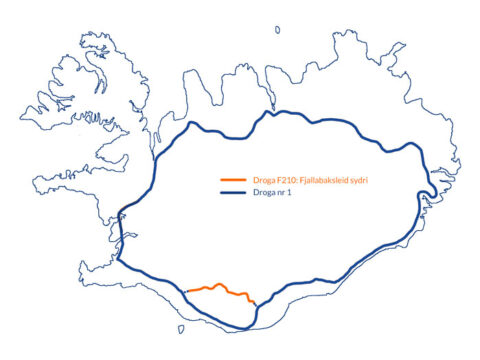 Like F208, F210 is also located in southern Iceland and passes through the Fridland ad Fjallabaki reserve. However, this road heads west, passing south of Hekla and north of Thorsmork. The F233 and F208 diverging from it can be used to reach Landmannalaugar to the south. On the other hand, the southbound F261 will take you to the northern slopes of Thorsmork (but you won’t enter the main valley) and to the Emstrur-Botnar Hut and the Markarfljótsgljúfur.
Like F208, F210 is also located in southern Iceland and passes through the Fridland ad Fjallabaki reserve. However, this road heads west, passing south of Hekla and north of Thorsmork. The F233 and F208 diverging from it can be used to reach Landmannalaugar to the south. On the other hand, the southbound F261 will take you to the northern slopes of Thorsmork (but you won’t enter the main valley) and to the Emstrur-Botnar Hut and the Markarfljótsgljúfur.
It is a beautiful road, but dangerous for two reasons. The first is the very frequent, large and deep potholes, or simply huge holes in the road. In places, they really make it impossible for even a large off-road vehicle to drive smoothly.
The second danger, but also one of the advantages of this road, are the wide and extensive fords you have to drive through here. In some parts you even drive in the middle of the stream along its course, and for quite a large chunk of it.Such a road naturally requires great attention. Wider fords, where you can’t see the bottom, are really worth seeing here by crossing them barefoot (or sending someone from the crew barefoot…). This will make sure where the depth of the stream is and – last but not least! – whether there isn’t a sandy, unstable bottom lurking somewhere that your car could get buried in.
Remember that most rental companies do not allow you to cross fords with water reaching above the centerline of the car. Only you know if you can handle deeper water.
If you already know whether you want to visit the mountain roads or stay on the ‘one’, see in the next article what car will best fit your plan and how much the different solutions cost (e.g. car + insurance + accommodation). You can read all about it here: What car to rent in Iceland.
Since the cost of your trip is greatly affected by the level of insurance you take out, while the insurance available in Iceland is a separate big topic, we’ve covered it in a separate article: Car Insurance in Iceland.
Road conditions in Iceland are quite specific. Even in summer, there are many things to watch out for. In addition, some traffic laws are unique, and the amount of fines can knock you off your feet. Since you’re planning to visit Iceland by car, be sure to read our road conditions, regulations and fines in Iceland.
We also encourage you to take a look at our list of Iceland’s Greatest Attractions [Top 10] and our detailed and accurate driving plan proposal: Best plan for Iceland (summer, 4×4, 14 days).